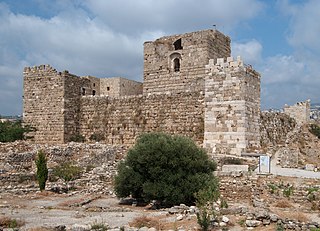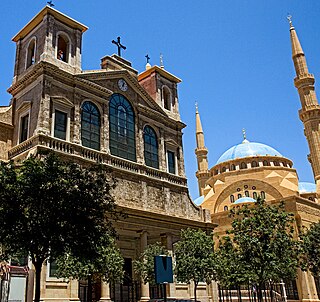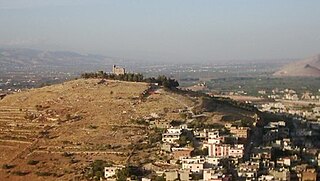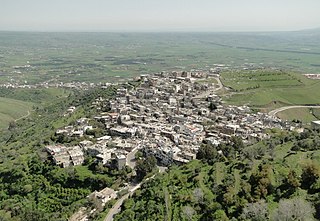
Tripoli is the largest and most important city in northern Lebanon and the second-largest city in the country. Situated 81 km (50 mi) north of the capital Beirut, it is the capital of the North Governorate and the Tripoli District. Tripoli overlooks the eastern Mediterranean Sea, and it is the northernmost seaport in Lebanon. The city is predominantly inhabited by Sunni Muslims, with smaller populations of Alawites and Christians, including Maronites and Armenians among others.

The Maronite Eparchy of Saint Maron of Sydney is a Maronite Church ecclesiastical jurisdiction or eparchy of the Catholic Church in Australia. In 2010 there were 160,000 members. It is currently ruled by Eparch Antoine-Charbel Tarabay, OLM.

Byblos Castle is a Crusader castle in Byblos, Lebanon. In Crusader times it was known as the Castle of Gibelet, also spelled Giblet, which belonged to the Genoese Embriaco family, Lords of the city. It is adjacent to the Phoenician archaeological site containing the ruins of the Temple of Baalat Gebal and the Temple of the Obelisks.

The tourism industry in Lebanon has been important to the local economy historically and comprises a major source of revenue for the country.

Collège Notre-Dame de Jamhour is a private Catholic primary and secondary school, located in Jamhour, in the Baabda District of the Mount Lebanon Governorate, Lebanon. The co-educational French-language school was founded by the Society of Jesus.

The Citadel of Tripoli is a 12th-century fortress in Tripoli, Lebanon. It was built at the top of a hill "during the initial Frankish siege of the city between 1102 and 1109" on the orders of Raymond de Saint-Gilles, who baptized it the Castle of Mount Pilgrim while local Muslims have been referring to it as the Castle of Saint-Gilles.

Majdal Anjar is a village of Beqaa Governorate, Lebanon. Majdal Anjar is an overwhelmingly Sunni Muslim town.

Kaukaba, Kaukabet El-Arab or Kaukaba Station is a village in the Hasbaya District in the Nabatiye Governorate in southern Lebanon.
Ras Baalbek I is a rock shelter 500 m (1,600 ft) east of Ras Baalbek in the northern Beqaa Valley in Lebanon. It sits north of the Wadi Teniyet er-Râs valley at a height of 1,000 m (3,300 ft). It was first discovered by Lorraine Copeland and Peter Wescombe in 1965–1966. It was later excavated by Jacques Besançon in 1970. Retouched blades along with a pressure-flaked arrowhead and a burin were found dated to the Neolithic period.
Tahun ben Aissa is an archaeological site about 3.5 kilometres southwest of Joub Jannine in the Beqaa Valley in Lebanon.
Antelias Cave was a large cave located 2.5 km (1.6 mi) east of Antelias, 10 km (6.2 mi) northeast of Beirut close to the wadi of Ksar Akil.

The architecture of Lebanon embodies the historical, cultural and religious influences that have shaped Lebanon's built environment. It has been influenced by the Phoenicians, Romans, Byzantines, Umayyads, Crusaders, Mamluks, Ottomans and French. Additionally, Lebanon is home to many examples of modern and contemporary architecture. Architecturally notable structures in Lebanon include ancient thermae and temples, castles, churches, mosques, hotels, museums, government buildings, souks, residences and towers.

The Eparchy of Saint Maron of Brooklyn is a Antiochene Syriac Maronite Church eparchy of the Catholic Church headquartered in Brooklyn, New York for the East Coast of the United States. In conformity with the Code of Canons of the Eastern Churches (CCEO), the eparchy is under the direct jurisdiction of the Roman Pontiff. In 2017 there were 33,000 baptized. It is currently ruled by eparch Gregory John Mansour.
Tell Ain Cerif is an archaeological site 4 kilometres (2.5 mi) north northwest of Rayak in the Beqaa Mohafazat (Governorate), Lebanon. It dates at least to the Chalcolithic.
Tell Shamsine is an archaeological site 1.75 km north northeast of Ain Anjar in the Beqaa Mohafazat (Governorate) in Lebanon. It dates at least to the Neolithic.
Tell Wardeen is an archaeological site 9 km northwest of Baalbek, 6 km east southeast of Bodai in the Beqaa Mohafazat (Governorate) in Lebanon. It dates at least to the early Bronze Age.

The Battle of Hosn was a one-day battle during the Syrian Civil War around the village of Hosn and its proper center in the 900-year-old medieval Crusader castle of Krak des Chevaliers, a UNESCO World Heritage Site, that had been in the hands of rebel fighters along with Hosn itself since 2012. The Syrian Army's objective during the battle was to sever the rebels' supply routes for recruits and weapons coming in and out of Lebanon.
This page is based on this
Wikipedia article Text is available under the
CC BY-SA 4.0 license; additional terms may apply.
Images, videos and audio are available under their respective licenses.














